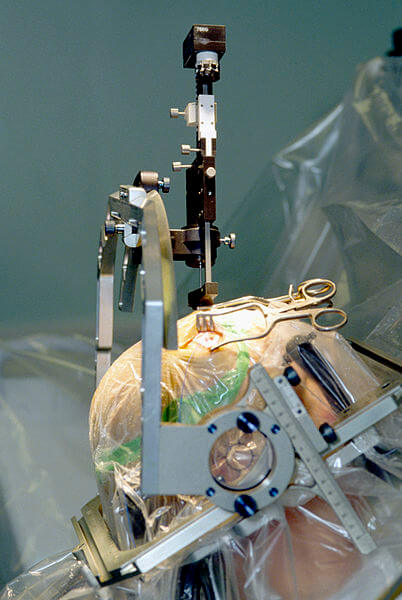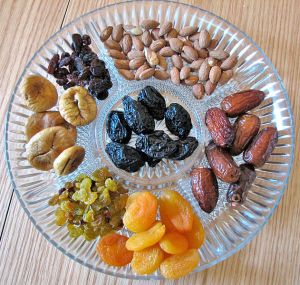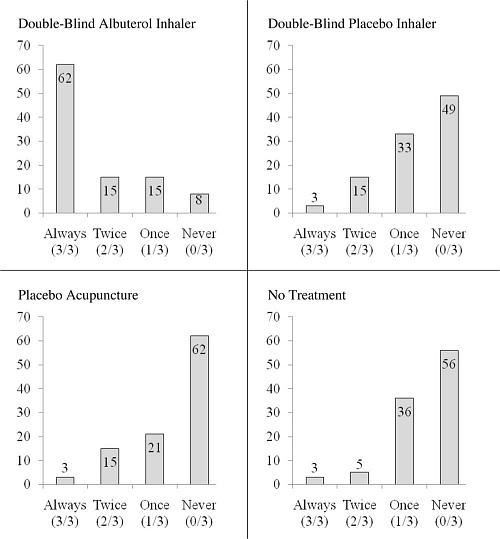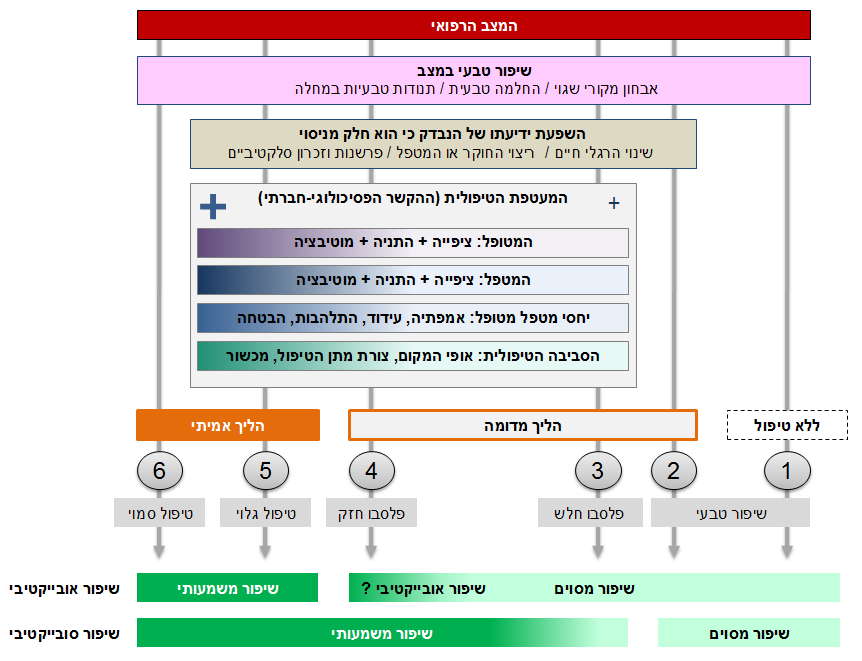We ended the previous entry with a serious sense of confusion. At least for me, it took many days to understand what is happening here: is the placebo a myth or a powerful phenomenon?

You the previous record We ended up feeling seriously confused. At least for me, it took many days to understand what is happening here: Is the placebo a myth or a powerful phenomenon?
On the one hand We met researchers who showed that when all the biases and factors of natural recovery are removed, there is almost no difference left between those receiving sham treatment and those who received no treatment at all, meaning that the placebo effect is only a myth. On the other hand, we surveyed A long line of studies which showed that classical conditioning, expectation and different learning mechanisms have the power to create impressive effects for placebo treatments. What is going on here?
In this post I will try to dispel the fog a little.
Comparing apples and oranges. and dates. and plums.

We will return to the studies of the Danish researchers, those who claimed that the placebo is actually a myth, and examine them more carefully. This examination will provide us with some good clues to the great confusion.
To a large extent, the Danish researchers mixed apples, oranges, dates and plums (and maybe some raisins too) in their super review. When examining subgroups of the studies included in the review, they find that The placebo effect did show superiority in the face of lack of care, in the following situations (The researchers note this themselves):
* Treatments that included physical intervention (e.g. sham acupuncture), compared to giving a pill. => We already know that the size of the effect is affected by the level of expectation, and the level of impression of the treatment, so this finding is not surprising.
* Studies whose main purpose was to test the placebo effect, compared to clinical trials. => It is very likely that the protocol was more suitable for revealing the effect in its full strength.
* Studies in them No Subjects were told that they might receive a sham treatment, that is, they were convinced that the sham treatment they were receiving was real. This is not the typical state of affairs for clinical trials in which the subject is informed in advance that there is a 50% chance (on average) that he will not receive the real treatment. => This fact is not surprising either, since the level of expectations is much lower if the patient knows that he may not receive real treatment.
* Treatments in which the patients subjectively assess their condition (eg pain or depression) compared to objective measurements (eg blood pressure or sugar level). => A critical point to which we will return immediately.
In this context, it is worth highlighting another point. It is a known fact that Some subjects respond well to placebo and some do not. It is not yet known what characterizes those who respond versus those who do not. On the other hand, in most cases the results reported in studies are average The reactions of all the subjects (responders and non-responders). This confounding largely hides the strength of the placebo effect among the subgroup of responders. (Of course, there is a chicken-and-egg problem here, since if we don't know how to define in advance who are the ones who will respond, we can always choose only those who responded well, perhaps also for reasons completely coincidental or unrelated to the placebo. This is just a point for thought. It is possible that in the future we will be able to predict who they are The people who will respond well to the placebo, then it is clear that such a separation into subgroups is justified).
The Danes seem to have gone a little too far in their strong conclusions.
Objective or subjective improvement only?
Maybe we didn't notice, but the vast majority of the findings in the matter His power of the placebo increases from the patients' own assessments. A sense of improvement and relief in symptoms, feeling better, weaker pains - all these are factors that are difficult to impossible to measure objectively.
Before we continue, we will first sharpen the distinction between disease and illness.
|
Disease |
sandy |
| functioning Defective biological-physiological |
experience of poor health |
|
negatively affects the organism |
negatively affects Man |
|
explained by description the physiological processes that occur in the body |
Explained on a level the phenomena, as an experience |
|
can exist without illness, if it is not manifested in a symptomatic way |
can exist without any diagnosed disease |
Of course, in most cases there is a strong connection between the disease and the patient: the disease (the defect in the physiological processes) is reflected in the symptoms, which are experienced as illness.
It is important to add more, because this distinction does not take lightly the importance and "reality" of the patient's condition. Illness is the way the body expresses itself to the suffering person. This expression can be both subjective (pain, anxiety) and objective (difficulty in movement, breathing). In addition to this, since subjective experiences ultimately have an expression in brain function, these experiences can even be measured objectively by imaging brain activity, or measuring the levels of chemicals in the blood. This fact makes it difficult to draw a clear line between objective and subjective.
The research evidence regarding the placebo effect indicates that it mostly helps in relieving the patient, and not in curing the disease. The most researched and understood field today in connection with placebo is field The pain, which is mainly an expression of sick. The main evidence for the power of the placebo is coming from laboratory experiments (on healthy people in general) that they demonstrated Symptomatic relief short term.
There is little evidence of placebo efficacy cure diseases by change objective and measurable in the physiology of the disease in the body. This fact is reinforced in the Danish study.
Regarding studies that allegedly showed objective changes - most of them They did not compare placebo recipients to those who received no treatment at all, and therefore their conclusions are controversial (since it is possible that the source of the improvement is natural recovery).
Even in cases where an improvement in the patient's objective function is evident, support for this is not always found at the actual physical level. How is this possible? Recalls the story of the woman Haygarth examined, whose hand function improved not due to the release of the locked elbow, but due to the fact that she her pizza About the limitations of her movement due to excessive flexibility in other parts of the arm. similarly found Because sufferers of sleep disorders reported a subjective improvement in their condition after receiving a placebo treatment, but In practice there was no objective improvement in their condition.
There is evidence of improvements in objective measures in animal experiments, using the classical conditioning mechanism, but they have not yet been demonstrated in human experiments (For more information regarding the lack of evidence for objective improvement, see pp. 6-7 in this article).
The following experiment illustrates the point very clearly. As part of a study published in the summer of 2011 In asthma patients, each subject received three series of four different treatments each (in random order):
1) Inhaler treatment with an active substance
2) Inhaler treatment with an inactive substance
3) Sham acupuncture treatment (using special needles that do not enter the body)
4) Failure to provide treatment.
Since at this point we are already placebo experts, we are careful and note that the first two types of treatment were given in a double-blind manner (even the therapist did not know whether they received an inhaler with an active substance or a sham), the sham acupuncture was only blinded by the patient (the therapist knew that it was a sham acupuncture), And the non-treatment group was not blinded, of course, since everyone knew who did not receive treatment that day. We would add and point out that the "no treatment" group is different from a group that did not participate in the experiment at all, because all the biases we mentioned stemming from the very fact that the subjects participate in the experiment, receive treatment and attention, undergo lung function tests, perhaps want to please the therapist, etc., these biases proletariat on this group. At the same time, such a group will clear factors of natural fluctuations in the disease for example.
The results were instructive:
when the subjects were asked evaluate the improvement in their condition Following the treatments, there was no big difference between the three treatments - all of them resulted in a significant improvement in the patients' condition, compared to no treatment (there was still an improvement, but much less impressive). In other words, The active substance had no distinct advantage over the placebo treatments, as far as the patients' evaluations are concerned.

But what happens when you check the condition of the patients in the form Objectively (by lung function test)? It turns out that the picture is completely different:

All the benefit of the placebo treatments over no treatment is gone (Although we still see a certain objective improvement in the three cases - probably natural fluctuations in the disease), while the active substance clearly did the job.
These results demonstrate the claim that the placebo manifests itself in a subjective improvement in feeling but not in an objective improvement in the physical condition.
It is equally interesting to compare what happened in each of the three therapeutic sessions that each subject received, i.e., what percentage of the subjects responded objectively to the placebo inhaler all three times he received it? only twice? just one time? Never? And so for all other situations. Here, too, the findings are enlightening ("responder" is defined as someone whose lung function index improved by more than 12%):

While 62% of the subjects responded to the inhaler with the active ingredient all 3 times they received it, only 3% responded all three times to any of the other conditions. The vast majority responded to them once out of three, if at all.
In light of the evidence we have today, it is possible to define The placebo response as a collection of psychological-neurological mechanisms that ease the person's experience of illness (even if only at the symptomatic level).
The expectation of recovery, the desire to recover, the trust in the therapist and the treatment, the empathetic, encouraging and hopeful attitude and reassurance on the part of the therapist - all these reduce the patient's stress, anxiety and sense of uncertainty and make it easier for him to deal with the disease.
In this sense, the placebo effect is an accompanying and empowering component to both the natural recovery component and the physiological therapeutic procedure (chemical substance or surgical operation for example), although in itself it probably Which is not Affects the course of the disease on a physiological-objective level.
Until you find clear evidence of actual clinical activity of placebo treatment, it seems to me that this definition reflects the state of knowledge today and can be used by us when we move on to discuss placebo-based treatments.
Subtotal
The following model will help us put order in the mess (I built it based on parts of models I found in the various sources mentioned + I understood things).
Click on the diagram to open in a separate window:

At the top of the model appears the medical condition the condemned We have seen that there is no such thing as hormone-level pain, pancreatic cancer or a broken bone, and that it is impossible to draw direct conclusions from a placebo response in one condition regarding a placebo response in another medical condition.
The next ingredient is a “the improvement The natural", a component that cannot be neutralized in any experiment. It is about the body's automatic and even unconscious coping with the poor physiological state.
Below we will find biases that arise from the very fact that the subject knows that he is under medical surveillance. I don't think we would want to define them as part of the placebo response.
The next ingredient which is called "The therapeutic envelope” includes in it many elements on which we expanded the speech Before: the mechanisms of expectation, conditioning, motivation, trust in the treatment and the therapist, the therapist's faith in the treatment, the patient-patient relationship, the therapeutic environment - the place, the atmosphere, the surrounding equipment, the impression, all of these can have a significant effect on the way the patient Occupant the treatment and his condition. Most of the mechanisms in the therapeutic envelope require awareness on the part of the patient in order to have an effect.
The next level component is a “The technological cure". At this level, an active chemical substance is given, or a physiological/surgical procedure with proven effectiveness is performed. This effectiveness is guaranteed even if the patient is unconscious. At this level, a sham drug or other sham procedure can be given. This is the level that is referred to when talking about a placebo as an "inert substance, lacking any medical activity".
We will quickly review the moves and upheavals we have encountered so far, in light of the proposed model.
At the beginning of things, we encountered cases where skeptics suspected that a certain treatment was charlatanism. To reveal this, they compared route 5 (providing an apparently "real" procedure) and route 4 (providing a dummy procedure), and showed that there is no difference between them. The conclusions reached are that the "real" procedure demonstrated is an act of charlatanism, and that other powerful elements (belonging to the "therapeutic envelope") are responsible for the results.
The lesson was learned, and for decades the clinical trials of new drugs and treatments focused on comparing pathways 4 and 5 in order to distill the true effectiveness of the procedure being tested. In many cases, both routes produced impressive results, and the conclusion was that the placebo effect was enormous.
But then they realized that they had actually forgotten to compare the results to route 1, that is, to the situation where no treatment was given at all.
In other words, does the placebo effect in route 4 result from the power of the therapeutic shell or from natural healing? For this, you need to compare route 4 (which includes the therapeutic envelope) and route 1 (which does not include it). When the researchers collected the results of clinical trials in which there was information about The three The routes (1, 4 and 5), revealed that the results in route 4 were very similar to the results in route 1, meaning the placebo effect is negligible, and the findings are explained by a natural improvement in the condition.
But other trials (mainly in pain, and those designed to test the placebo effect itself and not the effectiveness of a new drug) showed a completely different picture. From these studies it emerged that there is a significant difference between the placebo and no treatment. How to settle this contradiction?
A closer examination shows that there is a very large range in the extent to which the therapeutic envelope contributes to the placebo effect. In the clinical trials that test new drugs, the effect of the "therapeutic envelope" is very small. The attitude towards the subjects is generally limited and correct, they are aware that they may receive a placebo and therefore their expectations are relatively low, etc. In fact, the researchers mainly compared route 3 (in which the therapeutic envelope has a small contribution to the effect) with route 1, in which there is no therapeutic envelope at all. No wonder then that the effect was extremely limited.
From studies that focused on the placebo effect itself, we learned a lot about the various factors and mechanisms that operate within the "therapeutic envelope".
In order to assess the contribution of the treatment envelope alone to the effect, separately from the simulated procedure, the researchers compared real overt and covert treatment (comparison of track 5 and 6), and the differences found (mainly in the study of painkillers) were impressive, that is, even in "real" treatments of various kinds The therapeutic envelope is significant.
In conclusion, we emphasized that most of the qualitative information accumulated so far regarding the placebo effect comes from studies In very certain areas, in healthy people and in short periods of time (Especially pain - which is easy to induce experimentally). Most of the evidence points to relief of symptoms as they are subjectively described by the patient, and not on actual physical healing that can be measured objectively.
One of the main and most essential controversies in the field at the moment is whether, and if so to what extent and in which situations, sham treatment has an objective clinical effect.
Armed with these understandings, it's time to tackle the most charged issue: If sham treatments ease the patient's suffering and his coping with his poor medical condition (sometimes impressively), why not give sham treatments?
We will deal with this in the next post

6 תגובות
Not fixed yet
After the matter is revealed we have to ask ourselves
Is our very observation of the placebo phenomenon
You won't change our attitude to placebo
That is
If I (after reading the article) have to undergo treatment
In the hospital it can be assumed that I will try special measures
Avoid the placebo and try to get the real treatment
Whether through acquaintances with doctors or money for a specialist
You can go on, but you get the point.
The very observation changes reality.
Guy, and what I wrote in the previous chapter about overt-covert? I think you are right. In the covert treatment the subjective improvement should be weaker. I will fix it.
'In the model'... not 'the model'.
monument,
There is a contradiction between tracks 5 and 6 of your model, in the subjective improvement, and what you wrote.
Thanks for the beautiful series of articles.
It only remains to ask:
When all this is known, how is it that the system responsible for health still does not provide the elementary "therapeutic envelope"? A doctor's long listening, a nurse's phone call can save so much pain for the patient, and for the system it will save a lot of money...